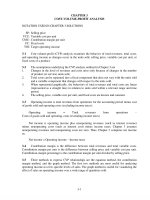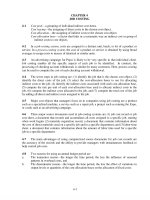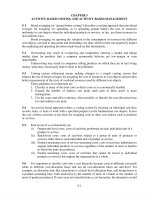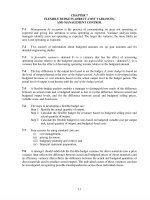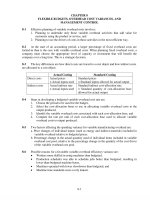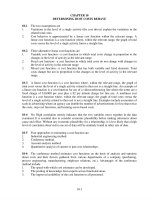Solution manual cost accounting 14e by horngren
Bạn đang xem bản rút gọn của tài liệu. Xem và tải ngay bản đầy đủ của tài liệu tại đây (1.17 MB, 40 trang )
To download more slides, ebook, solutions and test bank, visit
Solutions Manual
COST
ACCOUNTING
To download more slides, ebook, solutions and test bank, visit
To download more slides, ebook, solutions and test bank, visit
Solutions Manual
COST
ACCOUNTING
Fourteenth Edition
Charles T. Horngren
Srikant M. Datar
Madhav Rajan
Upper Saddle River, NJ 07458
© 2012 Pearson Education, Inc. Publishing as Prentice Hall
To download more slides, ebook, solutions and test bank, visit
This work is protected by United States copyright laws and is provided
solely for the use of instructors in teaching their courses and assessing
student learning. Dissemination or sale of any part of this work (including
on the World Wide Web) will destroy the integrity of the work and is not
permitted. The work and materials from it should never be made available
to students except by instructors using the accompanying text in their
classes. All recipients of this work are expected to abide by these
restrictions and to honor the intended pedagogical purposes and the needs
of other instructors who rely on these materials.
Acquisition Editor: Stephanie Wall
Editorial Project Manager: Christina Rumbaugh
Editorial Assistant: Brian Reilly
Project Manager, Production: Lynne Breitfeller
Operations Specialist: Natacha Moore
Printer/Binder: OPM Digital Print Services
Cover Printer: OPM Digital Print Services
Credits and acknowledgments borrowed from other sources and reproduced, with permission, in this
textbook appear on appropriate page within text.
______________________________________________________________________________________
Copyright © 2012 by Pearson Education, Inc., Upper Saddle River, New Jersey, 07458.
Pearson Prentice Hall. All rights reserved. Printed in the United States of America. This publication is
protected by Copyright and permission should be obtained from the publisher prior to any prohibited
reproduction, storage in a retrieval system, or transmission in any form or by any means, electronic,
mechanical, photocopying, recording, or likewise. For information regarding permission(s), write to: Rights
and Permissions Department.
Pearson Prentice Hall™ is a trademark of Pearson Education, Inc.
Pearson® is a registered trademark of Pearson plc
Prentice Hall® is a registered trademark of Pearson Education, Inc.
Pearson Education Ltd., London
Pearson Education Singapore, Pte. Ltd
Pearson Education, Canada, Inc.
Pearson Education–Japan
Pearson Education Australia PTY, Limited
Pearson Education North Asia, Ltd., Hong Kong
Pearson Educación de Mexico, S.A. de C.V.
Pearson Education Malaysia, Pte. Ltd
Pearson Education Upper Saddle River, New Jersey
10
9
8
7
6
5
4
3
2
1
ISBN-13: 978-0-13-210921-5
ISBN 10: 0-13-210921-2
To download more slides, ebook, solutions and test bank, visit
TABLE OF CONTENTS
Preface
v
Supplements Available for Fourteenth Edition
ix
Alternative Suggested Chapter Sequences
xiii
Categorization of Assignment Material
xvii
Presentation of Solutions
xxxi
Major Changes in Text for the Fourteenth Edition
xxxiii
Changes in Assignment Material for the Fourteenth Edition
xxxvii
Chapter Solutions
1
The Manager and Management Accounting
1-1
2
An Introduction to Cost Terms and Purposes
2-1
3
Cost-Volume-Profit Analysis
3-1
4
Job Costing
4-1
5
Activity-Based Costing and Activity-Based Management
5-1
6
Master Budget and Responsibility Accounting
6-1
7
Flexible Budgets, Direct-Cost Variances, and Management Control
7-1
8
Flexible Budgets, Overhead Cost Variances, and Management Control
8-1
9
Inventory Costing and Capacity Analysis
9-1
10
Determining How Costs Behave
10-1
11
Decision Making and Relevant Information
11-1
12
Pricing Decisions and Cost Management
12-1
13
Strategy, Balanced Scorecard, and Strategic Profitability Analysis
13-1
14
Cost Allocation, Customer-Profitability Analysis, and Sales-Variance Analysis
14-1
15
Allocation of Support-Department Costs, Common Costs, and Revenues
15-1
16
Cost Allocation: Joint Products and Byproducts
16-1
17
Process Costing
17-1
18
Spoilage, Rework, and Scrap
18-1
19
Balanced Scorecard: Quality, Time, and the Theory of Constraints
19-1
20
Inventory Management, Just-in-Time, and Simplified Costing Methods
20-1
21
Capital Budgeting and Cost Analysis
21-1
22
Management Control Systems, Transfer Pricing, and Multinational Considerations
22-1
23
Performance Measurement, Compensation, and Multinational Considerations
v
23-1
To download more slides, ebook, solutions and test bank, visit
vi
To download more slides, ebook, solutions and test bank, visit
PREFACE
The keys to the success of a course in cost accounting are the assignment and discussion of
provocative problem material. The gathering of high-quality assignment material has been a
crucial phase of this book‘s preparation – not a painful afterthought.
Please review the preface in the text in conjunction with examining the suggestions in this
Solutions Manual. Please also read all the front matter of this manual.
Anna Jensen, Barbara Durham, Anna Jensen and Shalin Shah assisted us greatly with
contributing, critiquing, and checking of the problems and their solutions. We thank them for
their many wonderful contributions.
We deeply appreciate the tremendous support of Caroline Roop, Aimée Hamel, and Shalin Shah.
Their ability to cheerfully respond to the many challenges made our tasks much more
manageable. We further appreciate the technical support for data analysis provided by DeYett
Law.
We are thankful to Stephanie Wall and Christina Rumbaugh at Prentice-Hall for providing
continual support in preparing this Solutions Manual.
CHARLES T. HORNGREN
SRIKANT M. DATAR
MADHAV V. RAJAN
vii
To download more slides, ebook, solutions and test bank, visit
SUPPLEMENTS AVAILABLE FOR THE FOURTEENTH EDITION
A complete package of supplements is available to assist students and instructors in using
Cost Accounting: A Managerial Emphasis
MyAccountingLab: for Horngren Cost Accounting 14e
MyAccountingLab is an online homework and assessment tool, designed to help students
practice cost accounting problems and concepts, and give their instructors feedback on their
performance. It lets cost accounting professors assign a homework deliverable that is
automatically graded, but that also serves as a tutorial experience for students.
Based on Pearson‘s MathXL platform that has graded over millions of assignments,
MyAccountingLab provides a strong, reliable platform with a rock solid performance history. To
learn more visit www.myaccountinglab.com.
For Instructors
Instructor Resource Center (IRC)
These password-protected resources are accessible from www.pearsonhighered.com for Cost
Accounting, 14th ed. Resources Include:
Instructor‘s Manual
Test Item File
Test Gen EQ—A computerized test item file.
Solutions Manual
Image Library—Access to most of the images and illustrations featured in the text.
Excel Labs and their solutions. Also included are the Excel files of the figures and tables
in the text.
Complete PowerPoint Presentations
NEW PowerPoint slides of fully-worked-out solutions for selected problems.
Support for Blackboard and WebCT courses
Instructor’s Manual
By Sheila Handy
© 2012 | 0-13-210924-7 | Online
Chapter by chapter manual offers helpful classroom suggestions and teaching tips
Test Item File
© 2012 | 0-13-210922-0 | Online
This collection of tests for each chapter offers an array of questions ranging from easy to
difficult. An electronic version of these questions is also available. The Test Item File now
supports Association to Advance Collegiate Schools of Business (AACSB) International
Accreditation.
viii
To download more slides, ebook, solutions and test bank, visit
Solutions Manual
© 2012 | 0-13-210921-2 | Paper
This manual contains the fully worked-out and accuracy-checked solutions for every question,
exercise and problem in the text.
Power Point Presentations
© 2012 | 0-13-210997-2 | Online
Chapter by chapter presentations that provide you with a slide show ready for classroom use. Use
the slides as they are, or edit them to meet your classroom needs.
For Students
Student Study Guide
by John K. Harris
© 2012 | 0-13-210920-4 | Paper
This chapter-by-chapter learning aid effectively helps students learn cost accounting and get the
maximum benefit from their study time. Each chapter provides a Chapter Overview and Review,
a Featured Exercise that covers all of the most important chapter material, and Review Questions
and Exercises with Solutions that best test the students‘ understanding of the material.
Student Solutions Manual
© 2012 | 0-13-210919-0 | Paper
This manual contains the fully worked-out and accuracy-checked solutions for selected end-ofchapter problems in the text.
Excel Manual for Cost Accounting
By Laurie Burney and Michelle Matherly
© 2012 | 0-13-2109182 | Paper
This brief supplement is aligned to bring students up to speed with using Excel in this course.
Student Download Page --- Horngren
URL: www.pearsonhighered.com/horngren
Our Companion Website provides students with chapter learning objectives and chapter by
chapter self-study quizzes.
--- For Students: Excel templates for selected and –of-chapter exercises and problems
(marked with an icon) are available online. These templates allow students to complete
selected exercises and problems using Excel. The Focus is on having students use Excel
to understand and apply chapter content. This Excel-based learning is completely
optional; therefore, students may choose to solve these exercises and problems manually.
The Excel Labs can be found on the Instructor‘s Resource Center (IRC).
ix
To download more slides, ebook, solutions and test bank, visit
ALTERNATIVE SUGGESTED CHAPTER SEQUENCES
The Preface to Cost Accounting noted that our aim in organizing the material was to present a
modular, flexible organization that permits a course to be custom tailored. This section presents
six possible sequences for a first course in cost accounting. For each of these six sequences, we
also present the sequence of a second course that would result in coverage of many or all of the
topics in Cost Accounting. Outlines I–V all include Chapters 1 to 9 in varying orders of
sequence. Outline VI has a strong (almost exclusive) focus on the decision making role of cost
accounting.
We analyzed the sequences of chapters assigned by many users of the 13th edition. Although
many instructors tended to follow the sequence in the text, other instructors tailored sequences to
fit their particular desires. These tailored sequences varied considerably. By far the most popular
departure was to assign the chapter on process costing (Chapter 17) immediately after the
coverage of job costing (Chapter 4) and activity-based costing (Chapter 5). The next most
popular departure was to assign Chapter 10 after Chapter 2 or 3. All the accompanying
alternative assignment schedules have an optional provision to facilitate tailoring a course.
Obviously, instructors should alter any suggested sequence to suit their preferences.
OUTLINE I: This basic course provides a balance of topics between the major purposes of cost
accounting:
1. Calculating the cost of products, services, and other cost objects.
2. Obtaining information for planning and control and performance evaluation.
3. Analyzing relevant information for making decisions.
Finishing the first course with Chapters 11 and 12 means that topics with less procedural
emphasis are highlighted in the last weeks of the course; these two chapters also introduce topics
covered in more detail in a second course. Some instructors may assign Chapter 10 without using
the Appendix on ―Regression Analysis,‖ preferring to delay use of the Appendix until the second
course (especially if many students have not been exposed to regression analysis at the time of
the basic course).
OUTLINE II: This basic course covers the same chapters as Outline I, but assigns Chapter 10
(Determining How Costs Behaves) immediately after Chapter 3 (Cost Volume-Profit Analysis).
It also assigns the new Chapter 13 on Strategy, Balanced Scorecard, and Strategic Profitability
Analysis. This first part of the Second Course emphasizes cost management and performance
evaluation before covering the six chapters (14–20) on cost allocation and other aspects of
costing systems.
OUTLINE III: After covering Chapters 1 to 9 and 11 in the basic course, this sequence finishes
with a chapter on strategic issues (Chapter 13) and two chapters on cost allocation topics
(Chapters 14 and 15). Some instructors view it as important that students taking only one cost
accounting course become aware of how pervasive cost allocation issues are in practice.
OUTLINE IV: This basic course is similar to Outline II with one key exception; Chapter 17
(Process Costing) is covered immediately after Chapter 5. Many instructors prefer to cover job
costing and process costing in sequence so that their differences are highlighted.
x
To download more slides, ebook, solutions and test bank, visit
OUTLINE V: This basic course emphasizes technical cost accounting topics more than the other
five outlines. Chapters 17 and 18, extend Chapters 4 and 5; covering 4, 5, 17, and 18, as a single
section of the course provides students with a solid understanding of product costing alternatives.
OUTLINE VI: This basic course is adopted by instructors who wish to put most emphasis on the
decision making and performance evaluation aspects of cost accounting. Finishing the basic
course with Chapters 22 and 23 means that behavioral issues are highlighted in the final weeks of
the course.
xi
To download more slides, ebook, solutions and test bank, visit
BASIC
COURSE
OUTLINE I
Number of
Chapter
Sessions
1
(1)
2
(2)
3
(2)
4
(3)
5
(3)
6
(2)
7
(2)
8
(2)
9
(2)
10
(2)
11
(2)
12
(2)
Tests
Optional
SECOND
COURSE
Chapter
13
14
15
16
17
18
19
20
21
22
23
Tests
Optional
(3)
(4)
32
Number of
Sessions
(3)
(2)
(2)
(2)
(2)
(2)
(2)
(2)
(2)
(2)
(2)
(3)
(6)
32
OUTLINE II
Number of
Chapter
Sessions
1
(1)
2
(2)
3
(2)
10
(2)
4
(3)
5
(3)
6
(2)
7
(2)
8
(2)
9
(2)
11
(2)
12
(2)
13
(2)
Tests
(3)
Optional
(2)
32
Chapter
21
22
23
14
15
16
17
18
19
20
Tests
Optional
xii
Number of
Sessions
(3)
(2)
(2)
(3)
(2)
(2)
(3)
(2)
(2)
(2)
(3)
(6)
32
OUTLINE III
Number of
Chapter
Sessions
1
(1)
2
(2)
3
(2)
4
(3)
5
(3)
6
(2)
7
(2)
8
(2)
9
(2)
11
(2)
13
(2)
14
(2)
15
(2)
Tests
(3)
Optional
(2)
32
Chapter
10
12
21
15
17
18
19
20
22
23
Tests
Optional
Number of
Sessions
(2)
(2)
(3)
(2)
(3)
(2)
(2)
(3)
(2)
(2)
(3)
(6)
32
To download more slides, ebook, solutions and test bank, visit
BASIC
COURSE
SECOND
COURSE
OUTLINE IV
Number of
Chapter
Sessions
1
(1)
2
(2)
3
(2)
10
(2)
4
(2)
5
(2)
17
(2)
6
(2)
7
(2)
8
(2)
9
(2)
11
(2)
12
(2)
Tests
(3)
Optional
(4)
32
Chapter
13
21
22
23
14
15
16
18
19
20
Tests
Optional
Number of
Sessions
(3)
(3)
(2)
(2)
(3)
(2)
(2)
(2)
(2)
(2)
(3)
(6)
32
OUTLINE V
Number of
Chapter
Sessions
1
(1)
2
(2)
3
(2)
4
(3)
5
(3)
17
(3)
18
(2)
6
(3)
7
(2)
8
(2)
9
(2)
OUTLINE VI
Number of
Chapter
Sessions
1
(1)
2
(2)
3
(2)
10
(2)
4
(2)
5
(2)
6
(2)
11
(2)
12
(2)
13
(3)
22
(2)
23
(2)
Tests
Optional
Tests
Optional
Chapter
10
11
12
13
21
14
15
16
19
20
22
23
Tests
Optional
xiii
(3)
(4)
32
Number of
Sessions
(2)
(2)
(2)
(3)
(3)
(2)
(2)
(2)
(2)
(2)
(2)
(2)
(3)
(3)
32
Chapter
7
8
9
17
18
19
20
21
14
15
16
Tests
Optional
(3)
(5)
32
Number of
Sessions
(2)
(2)
(2)
(3)
(2)
(2)
(2)
(3)
(2)
(2)
(2)
(3)
(5)
32
To download more slides, ebook, solutions and test bank, visit
CATEGORIZATION OF ASSIGNMENT MATERIAL
The assignment material in the fourteenth edition has been developed to offer instructors a broad
range of options in developing a challenging and interesting course. The following exhibits assist
instructors in selecting assignment material.
Exhibits P-l and P-2 show assignment material that is based on service/nonprofit, merchandising
(retail, wholesale or distribution) sectors of the economy. While much assignment in the
fourteenth edition is based in the manufacturing sector, Exhibits P-l and P-2 provide many
examples for instructors to either select assignment material from a broad range of sectors or
indeed to concentrate on sectors outside manufacturing.
1.
SERVICE AND NONPROFIT SECTORS: Includes such settings as accounting firms,
law firms, advertising agencies, bank and finance companies, lodging companies,
transportation companies, and government agencies.
2.
MERCHANDISING SECTORS: Includes such settings as distributors, wholesalers, and
retailers.
There is growing demand from instructors for assignment material in three specific areas—
ethics, global or international, and modern cost management. Exhibits P-3 to P-5 show
assignment material in the fourteenth edition on these three topics.
3.
ETHICS. The second-last problem of many chapters incorporates an ethical issue facing
a management accountant or a manager. Examples include pressure for cooking the
books, concealing of unfavorable information, and conflicts of interest between
management incentives and company value. Many of these problems require students to
consider the "Standards of Ethical Conduct for Practitioners of Management Accounting
and Financial Management" on p.16 of the text.
4.
GLOBAL/INTERNATIONAL DIMENSIONS. Included assignment material based
outside the United States or problems pertaining to companies with operations in more
than one country.
5.
MODERN COST MANAGEMENT FRONTIER IDEAS. Includes assignment material
that an instructor can use to highlight areas such as customer focus, key success factors,
balanced scorecard, total value-chain analysis, strategic analysis of operating income,
JIT, and continuous improvement. Assignment material related to activity-based costing
(ABC), activity-based management (ABM), and cost drivers is found in many chapters.
xiv
To download more slides, ebook, solutions and test bank, visit
EXHIBIT P-1
ASSIGNMENT MATERIAL FROM SERVICE AND NOT-FOR-PROFIT SECTORS
Chapter Number
Context
1
1-22
House-painting service; five-step decision-making process
1-24
Internet company; planning and control
1-30
Publishing company; ethics; end-of-year actions
1-31
Shipping company; ethical challenges
2
2-18
2-21
2-24
2-26
Classification of costs, marketing research
Phone contract; fixed and variable costs
Publishing company; value chain, cost drivers
Total costs and unit costs of student entertainment
3
3-18
3-22
3-29
3-33
3-34
3-40
Travel agency; CVP analysis
Restaurant; CVP analysis
Music Society; CVP analysis
Tourism; CVP analysis
Daycare; CVP analysis, target operating income
Printing company; breakeven; alternative cost structures, uncertainty,
sensitivity
Computer retailer; CVP, alternative cost structures
Museum of art; gross margin, contribution margin
3-41
3-47
4
4-18
4-21
4-24
4-28
4-29
4-32
4-33
4-39
4-41
5
5-17
5-18
5-22
5-27
5-28
5-29
5-30
5-31
5-33
5-34
5-37
Residential construction; job costing, normal, actual
Consulting firm, job costing
University press; job costing, journal entries
Canadian accounting firm; actual, normal and variation from normal
costing
Architecture firm; actual, normal, and variation from normal costing
Law firm; job costing
Law firm; job costing
Printing; allocation and proration of overhead
Book signing agency; job costing
Testing labs; activity-based costing, cost hierarchy
Professional services firm; alternative allocation bases
Printing company; activity-based costing
Custom framing; activity-based costing
Banking; activity-based costing, product costing, cross-subsidization
Law firm; job costing, single direct- and indirect-cost categories
Law firm; job costing, multiple direct- and single indirect-cost
categories
Law firm; job costing, multiple direct- and indirect-cost categories
Radiology center; department, activity-cost rates
Dance studio, childcare, fitness; activity-based costing and management
Health care; activity-based costing system
xv
To download more slides, ebook, solutions and test bank, visit
EXHIBIT P-1 (Continued)
Chapter Number
Context
6
6-16
Environmental testing; sales budget
6-40
Hair salon; human aspects of budgeting
7
7-31
Car detailing; variance analysis
8
8-24
8-36
8-40
Food delivery service; overhead variances
Publishing company; activity-based costing
Pet food inspection; non-financial variances
9
9-31
9-39
9-40
University press; metrics to minimize inventory buildups
Hospital chain; cost allocation, downward demand spiral
Hospital chain; cost allocation, responsibility accounting, ethics
10
10-17
10-20
10-21
10-23
10-24
10-25
10-27
10-32
10-33
Car rental contracts; variable-, fixed- and mixed-cost functions
Car wash; account analysis method
Restaurant; account analysis method
Travel services; estimating a cost function, high-low method
Customer-service costs; estimating a cost function, high-low method
Consulting services; linear cost approximation
Catering company; regression analysis
Produce club; high-low method, regression analysis
Restaurant; sales and advertising, high-low method, regression analysis
11
11-24
11-26
11-27
Hospital; relevant costs, decision on closing surgery centers
Printing press; choosing customers
Auto wash company; relevance of equipment costs
12
12-19
12-20
12-23
12-27
12-31
12-32
12-33
12-33
12-35
12-36
Tool repair shop; value-added, nonvalue-added costs
Architects; target operating income, value-added costs
Hotel management; cost-plus target return on investment pricing
Hotel; price discrimination
Repair services; cost-plus, time and materials, ethics
Temp labor agency; cost-plus and market-based pricing
Testing labs; cost-plus and market-based pricing
Testing labs; cost-plus and market-based pricing
Airline; price discrimination
Art framing; preparing a bid, pricing, ethics
13
13-26
13-27
13-28
Consulting firm; strategy, balanced scorecard
Consulting firm; strategic analysis of operating income
Consulting firm; analysis of growth, price-recovery, and productivity
components
Consulting firm; identifying and managing unused capacity
13-29
xvi
To download more slides, ebook, solutions and test bank, visit
EXHIBIT P-1 (Continued)
Chapter Number
Context
14
14-16
Hospitals; cost allocation
14-18
Hotel; cost allocation to divisions
14-21
Repair service; customer profitability
14-23
Sports team; variance analysis, multiple products
14-38
Interior design; customer-cost hierarchy and profitability analysis
15
15-19
15-23
15-24
15-29
15-35
Management consulting; direct and step-down support department cost
allocation
Management consulting; reciprocal method support department cost
allocation
Allocation of common living costs
Consulting services; allocation of common travel costs
University; fixed cost allocation
Hotel; revenue allocation, bundled products
17
17-38
17-39
Publishing company; transferred-in costs, weighted-average method
Publishing company; transferred-in costs, FIFO method
19
19-21
19-22
19-23
19-30
19-37
Conference center; quality improvement, relevant costs and revenues
University; waiting time
University; waiting time, relevant costs, student satisfaction
Healthcare group; patient satisfaction, waiting time, compensation
Pizza delivery; quality improvement, Pareto diagram, cause-and-effect
diagram
21
21-18
21-19
21-22
21-24
21-34
Hospital; capital budgeting methods, no income taxes
Hospital; capital budgeting methods, income taxes
Construction company; payback and NPV methods, no income taxes
Bakery; new equipment purchase, income taxes
Fitness center; recognizing cash flows for capital investment projects,
NPV, income taxes
22
22-16
Theme parks; management control systems, balanced scorecard
23
23-17
23-29
23-32
Educational services; DuPont method
Restaurants; ROI, measurement alternatives for performance measures
Media group; ROI, RI, DuPont method, investment decisions, balanced
scorecard
Media group; division managers' compensation, levers of control
Bank; compensation, balanced scorecard, compensation
Health spas; RI, EVA, measurement alternatives, goal congruence
15-20
23-33
23-34
23-37
xvii
To download more slides, ebook, solutions and test bank, visit
EXHIBIT P-2
ASSIGNMENT MATERIAL FROM MERCHANDISING SECTORS
Chapter Number
Context
2
2-19
Classification of costs, merchandising sector
2-29
Department store; cost of goods purchased, cost of goods sold, and
income statement
2-30
Retail outlet store; cost of goods sold and income statement
3
3-19
3-21
3-23
3-25
3-28
3-30
3-32
3-38
3-39
3-46
Doughnut retailing; CVP
Car dealer; CVP analysis
Book publisher; CVP and sensitivity analysis
Rug dealer; space rental terms, operating leverage
Bagel shop; sales mix; CVP
Men's clothing retailer; contribution margin, decision making
Retail; uncertainty, expected costs
Shoe store; sales commissions, CVP analysis
Shoe store; sales commissions, CVP analysis
Luggage carrier retailer; sales mix, CVP
5
5-24
5-25
5-35
5-41
Supermarket; ABC, product-line profitability
Furniture wholesaler; ABC, customer profitability
Pharmaceuticals distributor; ABC
Bookstore; activity-based costing and management
6
6-24
6-25
6-27
6-37
Supermarket chain; activity-based budgeting
Supermarket chain; activity-based budgeting, kaizen budgeting
Video game distributor; cash flow analysis
Wholesaler; cash budgeting
10
10-40
10-41
10-42
Department store chain; cost drivers, ABC, simple regression analysis
Department store chain; cost drivers, ABC, multiple regression analysis
Clothing store; matching time periods, regression, ethics
11
11-22
11-25
Food store; relevant costs, contribution margin, product emphasis
Convenience stores; relevant costs, closing and opening stores
12
12-21
Distributor; target prices, target costs, ABC
13
13-18
13-19
13-20
T-shirts distributor; strategy, balanced scorecard
T-shirts distributor; strategic analysis of operating income
T-shirts distributor; analysis of growth, price-recovery,
and productivity components
T-shirts distributor; identifying and managing unused capacity
Clothing retailer; strategic analysis of operating income
13-21
13-39
xviii
To download more slides, ebook, solutions and test bank, visit
EXHIBIT P-2 (Continued)
Chapter Number
Context
14
14-20
Electronics distributor; customer profitability, customer-cost hierarchy
14-22
Pharmaceutical distributor; customer profitability
14-24
Wine glass retailer; variance analysis, multiple products
14-30
Bottled water distributor; customer profitability
14-34
Gelato stores; variance analysis, multiple products
15
15-21
15-25
15-26
15-27
15-33
Online book retailer; direct and step-down support department cost
allocation
Online book retailer; reciprocal method support department cost
allocation
Fragrance retailer; revenue allocation
Auto sales; allocation of common costs
Department store; single-rate, dual-rate and practical capacity allocation
Computer hardware sales; revenue allocation
20
20-16
20-17
20-18
20-26
20-29
Sporting goods retailer; EOQ
Sporting goods retailer; EOQ, effect of parameter changes
Textile retailer; EOQ
Linen retailer; effect of different order quantities, EOQ,
Online computer retailer; EOQ, performance evaluation
21
21-17
21-36
21-37
Hardware stores; capital budgeting methods, no income taxes
Food retailer; NPV, inflation, income taxes
Food franchise; NPV, internal rate of return, sensitivity analysis
23
23-22
23-26
Automobile retailer; ROI, RI, EVA
Car battery sales; risk sharing, incentives, benchmarking, multiple tasks
15-22
xix
To download more slides, ebook, solutions and test bank, visit
To download more slides, ebook, solutions and test bank, visit
EXHIBIT P-3
ASSIGNMENT MATERIAL ON ETHICS
Chapter Number
Context
1
1-23
Division performance
1-28
Pharmaceutical company, budgeting
1-29
End-of-year actions
1-30
End-of-year actions
1-31
Global company, end-of-year actions
2
2-41
Cost classification
3
3-48
Environmental costs, CVP analysis
4
4-40
Job costing, contracting, cost reimbursement
5
5-40
Electronics; ABC, implementation, ethics
6
6-39
Manufacturer; slack, ethics
7
7-41
Drum manufacturer; variances, standard-setting, benchmarking, ethics
8
8-42
Overhead variances, ethics
9
9-40
Hospital chain; cost allocation, responsibility accounting, ethics
10
10-42
Clothing store; matching time periods, regression, ethics
11
11-41
Dropping a customer, activity-based costing, ethics
12
12-31
12-36
Repair services; cost-plus, time and materials, ethics
Art framing; preparing a bid, pricing, ethics
13
13-33
Electronic component manufacturer; ethics
14
14-39
Writing smaller orders; customer profitability and ethics
19
19-18
19-38
Car seats; costs of quality, ethics
Auto parts manufacturer; ethics and quality
20
20-36
Container manufacturer; JIT production, relevant benefits, relevant
costs, ethics
22
22-35
Luggage manufacturer; transfer pricing, goal congruence, ethics
23
23-35
23-36
Semiconductors; manager's performance evaluation, ethics
Picture frame molding; levers of control, ethics
xxv
To download more slides, ebook, solutions and test bank, visit
EXHIBIT P-4
ASSIGNMENT MATERIAL WITH GLOBALOR INTERNATIONAL SETTING
Chapter Number
Context
1
1-31
Contract bidding, ethical and cultural issues
3
3-18
3-26
Travel agency, CVP analysis
International cost structure differences, CVP analysis
4
4-28
Canadian accounting firm; actual, normal and variation from normal
costing
6
6-22
Japanese motorcycle manufacturer; revenues, production and purchases
budgets
8
8-23
Telecommunications company; manufacturing overhead, standardcosting system
11
11-30
International outsourcing; relevant costs, exchange rates
21
21-26
21-29
Clothing manufacturer; selling a plant, income taxes
Fragrance manufacturer; DCF, sensitivity analysis, no income taxes
22
22-19
Multinational computer company; transfer pricing, global income-tax
minimization
Canadian lumber company; transfer-pricing methods, goal congruence
Telecommunications equipment, global marketing; multinational transfer
pricing, global tax minimization
Telecommunications equipment, global marketing; multinational transfer
pricing, goal congruence
Industrial diamonds; multinational transfer pricing, global tax
minimization
Component manufacturer; multinational transfer pricing, taxation, goal
congruence
22-20
22-23
22-24
22-32
22-33
23
23-24
22-30
23-31
Manufacturing, U.S. and Norway; multinational performance
measurement, ROI, RI
Manufacturing, U.S. and France; multinational performance
measurement, ROI, RI
Multinational firm, U.S., Germany, and New Zealand; performance
measurement, ROI, RI, cost of capital, taxes
xxvi
To download more slides, ebook, solutions and test bank, visit
EXHIBIT P-5
ASSIGNMENT MATERIAL USING MODERN COST MANAGEMENT FRONTIER IDEAS
Chapter
1
Number
1-16
1-17
1-18
1-19
1-25
2
2-24
Publishing company; value chain, cost drivers
5
5-16
5-17
5-19
5-20
5-39
5-40
5-41
Cost hierarchy at manufacturer
Testing labs; ABC, cost hierarchy
Automotive products; plantwide, department, ABC costing
Trophies and plaques manufacturer; plantwide, department, ABC
costing
Calculator manufacturer; ABC, process costing
Printing company; activity-based costing
Door manufacturer; activity-based costing
Supermarket; ABC, product-line profitability
Furniture wholesaler; ABC, customer profitability
Food processing; ABC, area cost-driver rates, product crosssubsidization
Custom framing; activity-based costing
Banking; ABC, product costing, cross-subsidization
Law firm; job costing, multiple direct- and single indirect-cost
categories
Law firm; job costing, multiple direct- and indirect-cost categories
Trophy manufacturing; plantwide, department, activity-cost rates
Radiology center; department, activity-cost rates
Dance studio, childcare, fitness; activity-based costing and management
Pharmaceuticals distributor; ABC
Bag manufacturer; activity-based costing and management
Health care; ABC system
Sports manufacturer; unused capacity, activity-based costing and
management
Machining shop; ABC
Electronics; ABC, implementation, ethics
Bookstore; activity-based costing and management
6-24
6-25
6-29
6-32
6-33
6-38
6-41
Supermarket chain; activity-based budgeting
Supermarket chain; activity-based budgeting, kaizen budgeting
T-shirt manufacturer; kaizen approach
Purchasing agent; responsibility accounting
Luggage manufacturer; activity-based budgeting
Plastic accessories manufacturer; activity-based budgeting
Footwear manufacturer; activity-based budgeting
5-21
5-22
5-23
5-24
5-25
5-26
5-27
5-28
5-30
5-31
5-32
5-33
5-34
5-35
5-36
5-37
5-38
6
Context
Computer company; value chain, cost classification
Pharmaceutical company; value chain, cost classification
Fast food restaurant; value chain, cost classification
Key success factors
Making strategic decisions
xxvii
To download more slides, ebook, solutions and test bank, visit
EXHIBIT P-5 (Continued)
Chapter Number
Context
7
7-25
Lamp manufacturer; continuous improvement
7-32
Sunglass frame/lens manufacturer; responsibility issues
7-38
Eyeglass lens manufacturer; use of variances for benchmarking
7-41
Drum manufacturer; variances, standard-setting, benchmarking, ethics
7-42
Electronics manufacturer; variances, standards, negotiations
8
8-35
8-36
8-37
8-41
9
9-17
9-19
9-25
9-26
9-31
9-34
Shoe manufacturer; activity-based costing, batch-level variance analysis
Publishing company; activity-based costing, batch-level variance
analysis
Jewelry maker; relationship between production-volume and salesvolume variance analysis
Cloth shopping bag maker; relationship between production-volume and
sales-volume variance analysis
9-36
9-39
9-40
Auto company; throughput costing
Electronics manufacturer; throughput costing
Capacity management, denominator-level capacity concepts
Motorcycle manufacturer; alternative denominator-level capacities
Textbook publisher; metrics to minimize inventory buildups
Denominator-level choices, changes in inventory levels, effect on
operating income
Electronics manufacturer; downward demand spiral
Hospital meal service; cost allocation, downward demand spiral
Hospital meal service; cost allocation, responsibility accounting, ethics
10
10-34
10-38
10-39
10-40
10-41
Manufacturing; cost drivers, ABC, simple regression analysis
Manufacturing; cost drivers, ABC, simple regression analysis
Manufacturing; cost drivers, ABC, multiple regression analysis
Department store chain; cost drivers, ABC, simple regression analysis
Department store chain; cost drivers, ABC, multiple regression analysis
11
11-19
11-20
11-26
11-36
11-41
Special order, activity-based costing
Make versus buy, activity-based costing
Printers; customer profitability analysis
Manufacturing; ABC, make versus buy
Customer profitability, activity-based costing, ethics
12
12-19
12-20
12-21
12-22
Tool repair shop; value-added, nonvalue-added costs
Architects; target operating income, value-added costs
Distributor; target prices, target costs, ABC
Medical instruments; target costs, effect of product-design changes on
product costs
Hotel management; cost-plus target return on investment pricing
Manufacturer; cost-plus, target pricing
Toy manufacturer; life-cycle product costing
Hotel; price discrimination
12-23
12-24
12-25
12-27
xxviii
To download more slides, ebook, solutions and test bank, visit
EXHIBIT P-5 (Continued)
Chapter Number
Context
12-28
Manufacturer; target pricing
12-29
Electronics; target prices, target costs, value engineering, cost
incurrence, locked-in costs, ABC
12-30
Candy manufacturer; target return on investment pricing
12-32
Temp labor agency; cost-plus and market-based pricing
12-33
Testing labs; cost-plus, activity-based costing, market-based pricing
12-34
Industrial site cleanup; life-cycle costing
12-35
Airline; price discrimination
12-37
Manufacturing; target prices, target costs, locked-in costs, value
engineering
13
13-16
13-17
13-18
13-19
13-20
13-33
13-34
13-35
13-36
13-37
13-38
13-39
Balanced scorecard
Analysis of growth, price-recovery and productivity components
Merchandising; strategy, balanced scorecard
Merchandising; strategic analysis of operating income
Merchandising; analysis of growth, price-recovery, and productivity
components
Merchandising; identifying and managing unused capacity
Manufacturing; strategy, balanced scorecard
Manufacturing; strategic analysis of operating income
Manufacturing; analysis of growth, price-recovery and productivity
components
Manufacturing; identifying and managing unused capacity
Consulting firm; strategy, balanced scorecard
Consulting firm; strategic analysis of operating income
Consulting firm; analysis of growth, price-recovery, and productivity
components
Consulting firm; identifying and managing unused capacity
Manufacturing; strategy, balanced scorecard
Manufacturing; strategic analysis of operating income
Manufacturing; analysis of growth, price-recovery, and productivity
components
Manufacturing; identifying and managing unused capacity
Balanced scorecard
Petroleum company; balanced scorecard
Laser printers; balanced scorecard
Manufacturing; partial productivity measurement
Manufacturing; total factor productivity
Clothing retailer; strategic analysis of operating income
14-20
14-21
14-22
14-29
14-30
14-31
Electronics distribution; customer profitability, customer-cost hierarchy
Repair service; customer profitability
Pharmaceutical distributor; customer profitability
Jewelry manufacturer; customer profitability
Bottled water distributor; customer profitability
Manufacturing company; customer profitability analysis
13-21
13-22
13-23
13-24
13-25
13-26
13-27
13-28
13-29
13-30
13-31
13-32
14
xxix


